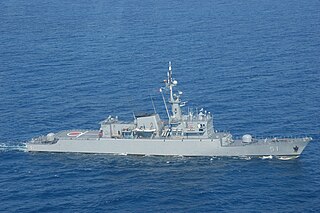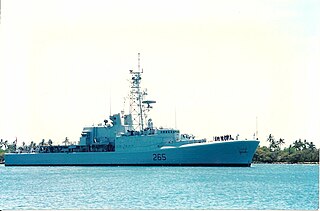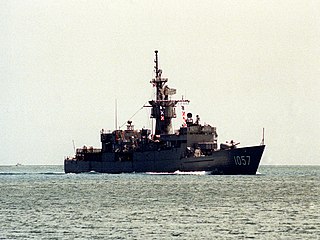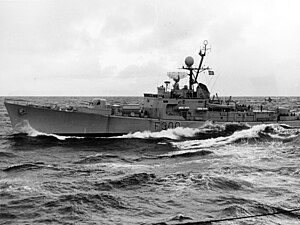Design and description
The Oslo class was based on the American Dealey-class destroyer escorts with modifications for northern sea conditions, including more freeboard forward. Oslo was 93.9 metres (308 ft 1 in) long between perpendiculars and 96.6 metres (316 ft 11 in) long overall with a beam of 11.2 metres (36 ft 9 in) and a draught of 5.3 metres (17 ft 5 in). The ship had a standard displacement of 1,450 long tons (1,473 t) and was 1,745 long tons (1,773 t) at full load. [lower-alpha 1] The frigate was powered by one set of STAL-de Laval PN20 double reduction geared turbines driving one shaft powered by steam provided by two Babcock & Wilcox boilers, rated at 20,000 shaft horsepower (14,914 kW). The ship had a maximum speed of 25 knots (46 km/h; 29 mph) and a range of 4,500 nautical miles (8,300 km; 5,200 mi) at 15 knots (28 km/h; 17 mph). Oslo was initially armed with four 3-inch (76 mm)/50 calibre guns mounted in twin turrets. [lower-alpha 2]
After a refit in the late 1970s Oslo mounted the two twin 3-inch mounts, six Penguin surface-to-surface missiles, one Mk 29 octuple launcher for Sea Sparrow surface-to-air missiles, carrying 24 missiles in total, and six Mk 32 324 mm (13 in) torpedo tubes in two triple mounts. The ship received her Mk 91 radar director for the Sea Sparrow missiles, and was fitted with DRBU 22, TM 1226 and HSA M 22 radars and SQS-36 sonar. In the late 1980s, Oslo underwent another modernisation. This time the aft twin 3-inch mount was removed to make space for the Teme III rocket-launched depth charges and 40 mm/70 calibre gun and Terne III and TSM 2633 hull and variable depth sonar and replacing the SQS-36. The frigate had a complement of 150 officers and ratings.

Iroquois-class destroyers, also known as Tribal class or DDG 280 class, were a class of four helicopter-carrying, guided missile destroyers of the Royal Canadian Navy. The ships were named to honour the First Nations of Canada.

The 46 Knox-class frigates were the largest, last, and most numerous of the US Navy's second-generation anti-submarine warfare (ASW) escorts. Originally laid down as ocean escorts, they were all redesignated as frigates on 30 June 1975, in the 1975 ship reclassification plan and their hull designation changed from 'DE' to 'FF'. The Knox class was the Navy's last destroyer-type design with a steam turbine powerplant.

The Halifax-class frigate, also referred to as the City class, is a class of multi-role patrol frigates that have served the Royal Canadian Navy since 1992. The class is the outcome of the Canadian Patrol Frigate Project, which dates to the mid-1970s. HMCS Halifax was the first of an eventual twelve Canadian-designed and Canadian-built vessels which combine traditional anti-submarine capabilities with systems to deal with surface and air threats as well. All ships of the class are named after a major city in each province plus the cities of Ottawa and Montreal.

The Andrea Doria class were helicopter cruisers of the Italian Navy. Italy's first major new designs of the post–World War II era, these ships were primarily designed for anti-submarine warfare tasks. Initially planned for three ships, the two ships that were constructed, Andrea Doria and Caio Duilio served until 1991 in both active and training capacities. The Andrea Doria class formed the basis for the larger Vittorio Veneto that followed them.

HMCS Yukon was a Mackenzie-class destroyer that served in the Royal Canadian Navy (RCN) and later the Canadian Forces. She was the first Canadian naval unit to carry the name. She was named for the Yukon River that runs from British Columbia through Yukon and into Alaska in the United States.

The Almirante Padilla-class frigates is a series of frigates operated by the Colombian Navy. The designation of this class is Type FS 1500 and there are four ships in service. The ships were built by Howaldtswerke-Deutsche Werft (HDW) at Kiel, West Germany in the 1980s, with the first vessel commissioning in 1983 and the last in 1984. The frigates have undergone significant modification over their careers with the 2012 Orion Program Upgrade significantly modernising the vessels. Two similar ships operate as the Kasturi-class corvettes in the Royal Malaysian Navy.

HMCS Annapolis was an Annapolis-class destroyer that served in the Royal Canadian Navy and later, the Canadian Forces. She was the second Canadian naval unit to carry this name. Named for the Annapolis River that flows through Nova Scotia, the ship entered service in 1964, the last of the St. Laurent-class design. Serving through the Cold War, Annapolis was decommissioned in 1998 before going through a protracted legal battle for use as an artificial reef. She was finally scuttled as such in 2015 off the coast of British Columbia.

The Claud Jones-class destroyer escorts were four destroyer escorts built for the United States Navy in the late 1950s. These ships were a diesel-powered version of the earlier Dealey class and were designed with the aim of producing a cheaper ship suitable for rapid production in wartime. These ships also had reduced armament and speed compared to their predecessors. They were not seen as effective anti-submarine warfare vessels by the United States Navy and were sold after only 15 years service to the Indonesian Navy.

NNS Aradu (F89) is a Nigerian frigate. She is the first of the MEKO 360 general purpose frigates built by the German Blohm + Voss company of Hamburg. The 125.6-metre ship is the largest in the Nigerian Navy. As a general purpose frigate, Aradu has capabilities for anti-air, anti-surface and anti-submarine warfare effectively, and participated in the 200th anniversary celebrations of the Battle of Trafalgar. The ship also possesses capability for naval fire support and electronic warfare. Additionally, she carries a ship-borne helicopter for anti-submarine warfare, search and rescue, and enhanced surveillance/detection.

USS Gray (FF-1054) was a United States Navy Knox-class frigate. She was named for Marine Corps Sergeant Ross F. Gray, who was a posthumous recipient of the Medal of Honor.

USS Rathburne (FF-1057) was a Knox-class frigate of the US Navy. Despite the different spelling, she was named for Continental Navy officer John Rathbun (1746-1782).

HMCS Saskatchewan was a Mackenzie-class destroyer that served in the Royal Canadian Navy (RCN) and later the Canadian Forces. She was the second Canadian naval unit to bear the name HMCS Saskatchewan. The ship was named for the Saskatchewan River which runs from Saskatchewan to Manitoba in Canada.

The Annapolis-class destroyer escort was a two-ship class of destroyer escorts that saw service with the Royal Canadian Navy and Canadian Forces from the 1960s to the 1990s. The final version of the St. Laurent-class design, the class was used extensively for anti-submarine warfare purposes. Both ships were sunk as artificial reefs after being retired, one on each coast of Canada.

HMCS Chaudière was a Restigouche-class destroyer and the second vessel of her class that served in the Royal Canadian Navy and later the Canadian Forces from 1959 to 1974. She was the second Canadian naval unit to bear this name. During the summer of 1974 she along with her sister ship HMCS Columbia served as the base of operations for the Esquimalt Sea Cadet Camp while being docked at the DND jetty in Colwood. This location was across the harbour from the main site of CFB Esquimalt. Following the vessel's decommissioning, the ship was used as a source for spare parts for the other surviving members of her class. In 1991, Chaudière was sold for use as an artificial reef and sunk off the coast of British Columbia.

The João Coutinho-class corvettes were a series of warships built for the Portuguese Navy for service in Portugal's African and Indian colonies. Initially rated as frigates, they were downgraded first to corvettes and then patrol vessels with age. They were designed in Portugal by naval engineer Rogério de Oliveira, but the urgent need of their services in the Portuguese Colonial War meant that the construction of the ships was assigned to foreign shipyards. Six ships were built; the first three ships were built by Blohm & Voss and the remaining three by Empresa Nacional Bazán. The ships were launched in 1970 and 1971. The relative cheap cost of the design led to it being the basis of several other classes in other navies. From 1970 until the end of the conflict in 1975, the corvettes were used for patrol and fire-support missions in Angola, Mozambique, Guinea and Cape Verde. After the African colonies gained their independence, the corvettes were assigned to patrol duties in Portuguese territorial waters.

HMCS Gatineau was a Restigouche-class destroyer that served in the Royal Canadian Navy and later the Canadian Forces during the Cold War from 1959 to 1996. She was the third ship in her class and the second vessel to carry the designation HMCS Gatineau. She was sold for scrapping in 2009.

HMCS St. Croix was a Restigouche-class destroyer that served in the Royal Canadian Navy and later the Canadian Forces from 1958 to 1974. The fourth ship commissioned in the class, she was the second ship to bear the name. Following her decommissioning, the ship was used as a training ship at Halifax, Nova Scotia until 1991, when St. Croix was sold for scrapping.

HMCS Columbia was a Restigouche-class destroyer that served in the Royal Canadian Navy and later the Canadian Forces from 1959 to 1974. Columbia was the seventh and final ship in her class and is the second Canadian naval unit to carry the name HMCS Columbia. Following her service, she was kept at Esquimalt in an altered condition, no longer capable of sailing. During the summer of 1974 she along with her sister ship HMCS Chaudiere served as the base of operations for the Esquimalt Sea Cadet Camp while being docked at the DND jetty in Colwood. This location was across the harbour from the main site of CFB Esquimalt. Columbia was sold for use as an artificial reef and sunk off the coast of British Columbia in 1996.

The Dealey-class destroyer escorts were the first post-World War II escort ships built for the United States Navy.
Dat Assawari was a frigate operated by the Libyan Navy. The ship was built by VT Group in the United Kingdom. It was ordered in February 1968 and delivered in 1973. The ship's design, the Vosper Mk 7 is a modified version of the Alvand-class frigate built for the Iranian Navy. The ship had an extensive refit in Italy by CNR Riva Trigoso 1979–1980 when new sensors and missiles were installed. During the refit, the ship was mined by unidentified swimmers. The vessel returned to service in 1983, but returned to Italy for repairs in 1984–1985 and 1989–1990. The frigate was reportedly scrapped in the late 1990s.



















